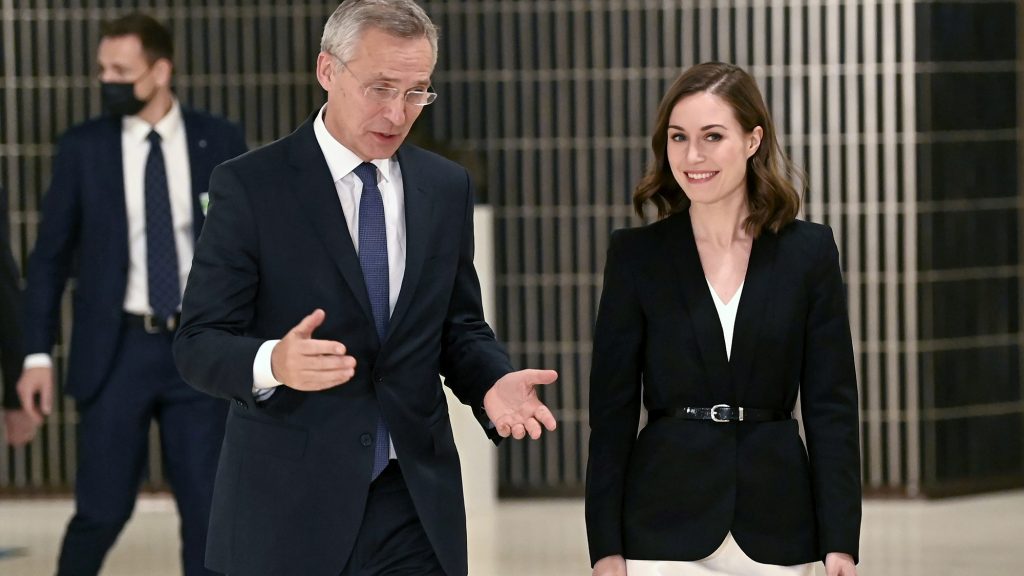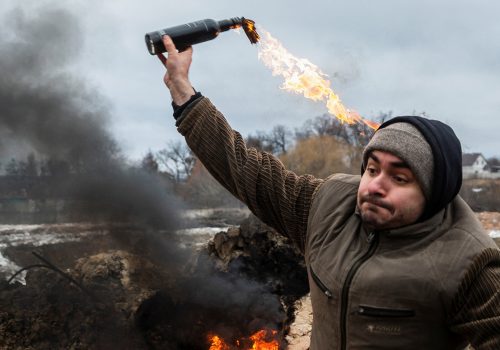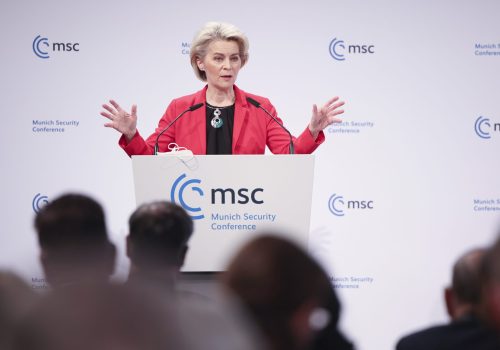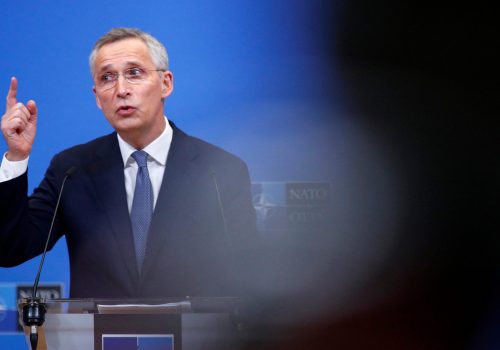A historic shift is taking place in Finland. For the first time, most Finns want to join NATO. Across the Baltic Sea, Swedes are becoming more favorable towards membership as well. Sparked by Russia’s full-scale invasion of Ukraine, this might lead to a major foreign-policy shift for the militarily non-aligned Nordic states. But it is not easy to take out insurance when the house is already on fire.
As many as 53 percent of Finns are now in favor of joining NATO, according to polling conducted from February 23-25 (the Russian invasion began on February 24). That’s a dramatic change: In 2017, the same poll showed only 19 percent of Finns wanting to join NATO, and the figure had remained rather stable over time. Polls in favor of joining NATO were up in Sweden as well, with 41 percent supportive in a poll released February 25, compared to 37 percent in January. Public endorsement for membership in Sweden has hovered around 35 percent since the Russian annexation of Crimea in 2014.
Clearly, Russia’s unprovoked war is pushing the two countries closer to NATO membership than ever before. Moscow´s recent, aggressive threats that joining NATO would bring “military and political consequences” upon Finland and Sweden seem to have had the opposite effect on the public. Rather than hiding in the ditches, Finns and Swedes are turning to the Alliance for security.
During the current crisis, both Finland and Sweden have repeatedly emphasized their sovereign right to choose their own national security strategy. Still, while Finnish and Swedish policies toward European Union membership and close partnerships with NATO might appear identical, underneath the surface are differences that might affect developments ahead.
On Tuesday, members of the Finnish parliament gathered to discuss the option of NATO membership, which is an explicit part of Finland’s national security strategy. Although only two out of ten parties in the parliament have been openly in favor of joining the Alliance, several parties are seeming to shift their position given Russia’s invasion of Ukraine.
For Finland, the shadow of history is always present. An 833 mile-long border with Russia means that Finland knows it can never take its sovereignty for granted. In his New Year’s speech, President Sauli Niinistö emphasized Finland’s sovereign right to choose its national security strategy, including the option to join NATO. He then quoted Henry Kissinger: “Whenever avoidance of war has been the primary objective of a group of powers, the international system has been at the mercy of its most ruthless member.”
Finland’s historical memories are not only about British Prime Minister Neville Chamberlain’s appeasement and the Munich agreement that left Czechoslovakia in the hands of Nazi Germany. Finns haven’t forgotten Soviet demands on their land and harbors in 1939, while secretly preparing for an invasion, which Moscow launched in November that year.
Those lessons were reiterated by Prime Minister Sanna Marin this week. Responding to Russian threats of “military consequences” if Finland and Sweden joined NATO, she stated: “We have shown that we have learnt from the past. We will not let go of our room for maneuver.”
In Sweden, the situation is different. The social democratic government prefers to emphasize that non-alignment has served Sweden well for more than two hundred years and that security policy should not be drastically changed, especially not in a volatile environment. Politically, NATO is a polarizing topic. The government does not want to refer to the option of joining NATO in the country’s national security doctrine, even though a majority of Parliament has demanded it since December 2020. Parliament is split on actual membership as well. Four parties are against NATO membership, and though four others are in favor, they don’t hold a majority of the seats. With national elections coming up in September, polarization is likely to prevail.
Given the greater support, traditionally, for NATO membership in Sweden as compared to Finland, the assumption in the region has long been that Stockholm would lead the way toward joining the Alliance. Now, it appears, the initiative might come from Finland instead, as evidenced by the many public appearances in recent weeks by senior Finnish officials where the NATO option was discussed. Even more Finns (66 percent) are in favor of NATO membership if Sweden also were to join the Alliance.
Given the two countries’ close defense cooperation and positions on NATO, applying for membership simultaneously would be the preferred option. However, even if it would not be optimal for Finland to make such a move without Sweden, Stockholm should have no illusion that any hesitation on its part will prevent Helsinki from choosing a path of its own. Given the speed of developments, this could happen sooner rather than later.
Of course, NATO must agree to admit Sweden and Finland, something that will require consensus among the thirty existing members. Sweden and Finland are two of six Enhanced Opportunity Partners (EOPs) for NATO—a group that also includes Ukraine—which constitutes the closest form of partnership with the Alliance. But Sweden and Finland are widely considered to be in a class by themselves among the EOPs because of the sophistication of their militaries, the stability of their democratic political systems, and their critical geography on the Baltic Sea bridging NATO’s Nordic and Baltic members.
Most observers believe that Swedish and Finnish applications to join the Alliance would find easy acceptance, a belief supported by the inclusion of the two countries at the extraordinary NATO Summit on February 25. In fact, NATO Secretary General Jens Stoltenberg addressed this issue during a recent Atlantic Council event, saying:
“If they decide to apply, and that’s a 100 percent Finnish and Swedish decision, then I think it is possible to make a decision quickly and for them to join quickly. At the end of the day, this has to be a political decision, but when you see the high level of interoperability between NATO and Finland and Sweden, when you see to what degree all of them meet NATO standards, it should be possible to allow them into our alliance quite quickly.”
What a fast-track process would look like to decide upon Swedish and Finnish membership remains to be seen. It would surely obviate the Membership Action Plan process that has been used to admit every NATO member starting with the 2004 enlargement round and which would likely apply to a country like Kosovo, which has already asked for accelerated membership in light of Russia’s invasion of Ukraine. Stoltenberg’s comments suggest that informal thinking is already underway about how this would work. If all parties were in agreement informally on the way ahead, we assess that it should take approximately a month to submit and consider the applications, and schedule a vote. The ratification processes in the thirty allied capitals would inevitably take much longer. In the meantime, the United States and the United Kingdom could issue interim security guarantees to Sweden and Finland. Washington, Stockholm, and Helsinki have an existing trilateral defense cooperation agreement that could be broadened and expanded for this purpose.
Events on the ground in Ukraine will likely dictate whether and how soon Sweden and Finland apply for NATO membership, and how readily the Alliance might admit them. But with the contours of European security irrevocably altered since Russia’s invasion of Ukraine, the direction of thinking in both countries—especially Finland—is getting clearer by the day. From Moscow’s perspective, the result might be another unwanted consequence of its needless and reckless aggression.
Anna Wieslander is the director for Northern Europe and head of the Northern Europe Office in Stockholm for the Atlantic Council’s Europe Center, as well as a former official in the Swedish Defense Ministry.
Christopher Skaluba is the director of the Transatlantic Security Initiative in the Atlantic Council’s Scowcroft Center for Strategy and Security. He previously served as principal director for European and NATO policy in the Office of the US Secretary of Defense.
Further reading
Wed, Mar 2, 2022
Molotov Cocktails in winter: What 1939 Finland tells us about Ukraine today
New Atlanticist By
But while Ukrainians may be prepping Molotov Cocktails, this winter war is already different.
Wed, Feb 23, 2022
What I heard in Munich: A lot of bold words, but little bold action
New Atlanticist By Anna Wieslander
As long as there are doubts about who belongs to Europe (and how), that means weakness and vulnerability for all.
Tue, Jan 18, 2022
No consensus? No problem. Why NATO is still effective.
New Atlanticist By Christopher Skaluba, Conor Rodihan
Don't believe what you hear: NATO can still contribute invaluably to Ukraine’s sovereignty.
Image: NATO Secretary General Jens Stoltenberg meets Finland's Prime Minister Sanna Marin during the The North Atlantic Council's (NAC) visit in Helsinki, Finland on October 25, 2021. Photo via Lehtikuva/Jussi Nukari via REUTERS .



